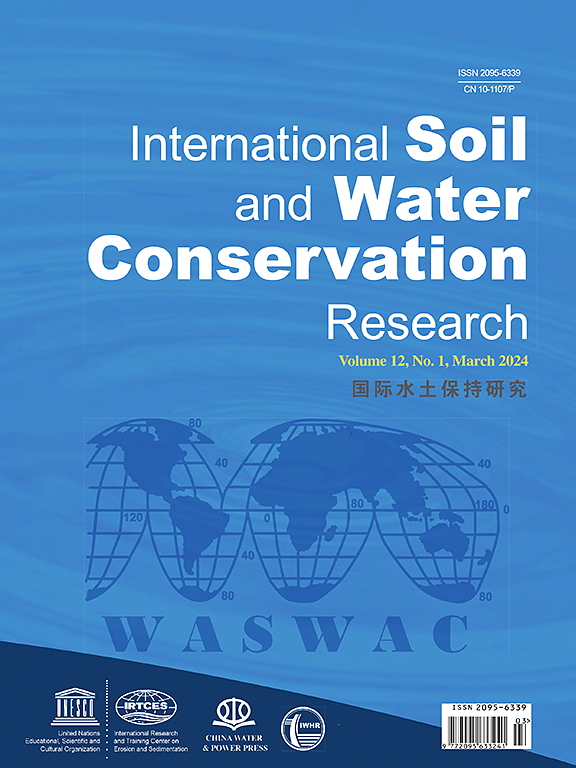Establishing and verifying soil quality index model based on GIS and remote sensing for cultivated lands under semi-humid terrestrial ecosystem
IF 7.3
1区 农林科学
Q1 ENVIRONMENTAL SCIENCES
International Soil and Water Conservation Research
Pub Date : 2024-10-17
DOI:10.1016/j.iswcr.2024.10.004
引用次数: 0
Abstract
Sustainable and efficient use of agricultural land depends on the potential characteristics of the soil. This potential directly affects the phenological growth and development of the crop to be grown. For these reasons, soil quality studies are of great importance in determining the products to be grown and the sustainability of the agriculture to be carried out. In this study, carried out in the Engiz Basin, a semi-humid terrestrial ecosystem of the Black Sea region, 250 soil samples were sampled from agricultural areas throughout the basin and a total of 26 soil physical, chemical and biological criteria were measured. Using Geographic Information Systems, Remote Sensing, Fuzzy-Analytical Hierarchy Process and Standard Scoring Function, soil quality models were constructed according to the obtained soil criteria. In addition, principal component analysis was used to select a minimum data set of the most sensitive indicators. The main physical criterion has the highest weight value with 0.611. The weight values for the highest sub-criteria of each main criterion - physical, chemical, biological, and fertility - were determined as slope (0.226), organic matter (0.425), microbial biomass carbon (0.512), and nitrogen (0.245), respectively. Geostatistical models were also used to produce maps of the spatial distribution of soil quality index values for the study area. Moreover, satellite image analysis and field studies (such as; data was collected from a face-to-face survey conducted with 51 farmers) were carried out to verify the obtained SQI distribution maps. The highest r2 values of 0.9004 were found between the SQITDS-L model and NDVI biomass reflectance values. Furthermore, when analyzing the statistical relationship between soil quality classes and yield and economic values obtained from the field, the high r2 value (0.8209) was determined.
基于GIS和遥感的半湿润陆地生态系统耕地土壤质量指数模型的建立与验证
农业用地的可持续和有效利用取决于土壤的潜在特性。这种潜力直接影响到作物的物候生长和发育。由于这些原因,土壤质量研究对于确定要种植的产品和要进行的农业的可持续性非常重要。本研究在黑海地区半湿润陆地生态系统Engiz盆地进行,从整个盆地的农业区采集了250个土壤样本,共测量了26个土壤物理、化学和生物指标。利用地理信息系统、遥感、模糊层次分析法和标准评分函数,根据得到的土壤标准构建土壤质量模型。此外,采用主成分分析方法选取最敏感指标的最小数据集。主物理指标的权重值最高,为0.611。各主要标准(物理、化学、生物和肥力)中最高子标准的权重值分别为坡度(0.226)、有机质(0.425)、微生物生物量碳(0.512)和氮(0.245)。地质统计模型还用于绘制研究区域土壤质量指标值的空间分布图。此外,卫星图像分析和实地研究(例如;数据收集自对51名农民进行的面对面调查),以验证获得的SQI分布图。SQITDS-L模型与NDVI生物量反射率的r2值最高,为0.9004。进一步分析土壤质量等级与田间产量和经济价值的统计关系,得到r2高值(0.8209)。
本文章由计算机程序翻译,如有差异,请以英文原文为准。
求助全文
约1分钟内获得全文
求助全文
来源期刊

International Soil and Water Conservation Research
Agricultural and Biological Sciences-Agronomy and Crop Science
CiteScore
12.00
自引率
3.10%
发文量
171
审稿时长
49 days
期刊介绍:
The International Soil and Water Conservation Research (ISWCR), the official journal of World Association of Soil and Water Conservation (WASWAC) http://www.waswac.org, is a multidisciplinary journal of soil and water conservation research, practice, policy, and perspectives. It aims to disseminate new knowledge and promote the practice of soil and water conservation.
The scope of International Soil and Water Conservation Research includes research, strategies, and technologies for prediction, prevention, and protection of soil and water resources. It deals with identification, characterization, and modeling; dynamic monitoring and evaluation; assessment and management of conservation practice and creation and implementation of quality standards.
Examples of appropriate topical areas include (but are not limited to):
• Conservation models, tools, and technologies
• Conservation agricultural
• Soil health resources, indicators, assessment, and management
• Land degradation
• Sustainable development
• Soil erosion and its control
• Soil erosion processes
• Water resources assessment and management
• Watershed management
• Soil erosion models
• Literature review on topics related soil and water conservation research
 求助内容:
求助内容: 应助结果提醒方式:
应助结果提醒方式:


